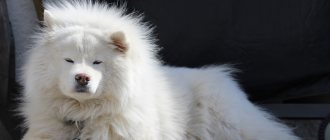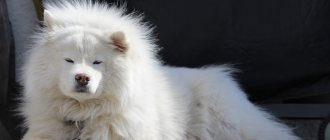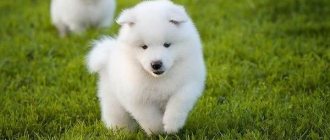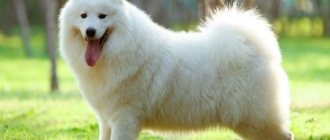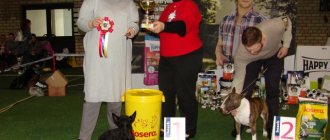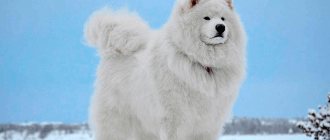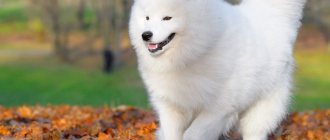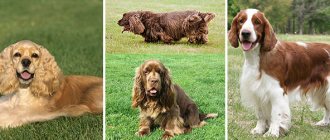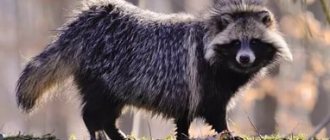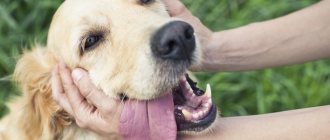Samoyed huskies are one of the most ancient dog breeds on Earth. They have a charming appearance, a wonderful flexible character and developed intelligence. Pets are very loyal to their owners and can easily withstand adverse weather conditions. The owners will be proud not only of the unusual appearance of their pet, but also of the status of the owner of a dog of such a rare breed, because there are only 2,500 of them in Russia. Let’s find out what else makes this breed different.
Brief history and characteristics of the breed
Scientists believe that the history of the Samoyed Laika breed goes back almost three thousand years. During all this time, Samoyeds have remained virtually unchanged. Their habitat was very limited, so they could not interbreed with other breeds. Actually, that’s why they are classified as primitive animals, which means there is no human intervention in the breeding of this breed. As a result, dogs have excellent health.
Currently, there is an opinion that the Samoyed is a hypoallergenic dog. They shed only twice a year, their fur does not have a special “dog” smell, and dandruff never forms on their skin. This means that allergens will not constantly fly around the house.
Expert opinion
Leonid Rodin
Experienced dog breeder
Ask a Question
The Samoyed Laika can be called a universal dog for all occasions. In their natural northern habitat, these intelligent animals were used for harnessing, reindeer herding, and as human companions. They were one of the first of all huskies to be exported to the Old World, where they quickly became fashionable among the aristocracy. It is known that the Danish princess Alexandra, who later became the wife of King Edward VII of Great Britain, had a special affection for Samoyeds. In the dog kennel under her patronage there lived a whole collection of dogs of this breed, and the queen devoted a lot of personal time to them. It is clear that aristocratic England also began to show interest in the exotic northern white huskies, gradually spreading the fashion for them to other European countries.
Why is the Samoyed husky called that?
There are two versions of the origin of such an unusual name for representatives of this dog breed.
According to the official version, these dogs were bred by some peoples living in the north of Siberia and the Urals, who are classified as Samoyedic groups. In ancient times they were called “samoyedny” or “samoyad”, which means “those who live separately, on their own, alone.” Gradually, the dogs living next to them were also named this way.
The second version of why this white husky is called a Samoyed has not been scientifically confirmed. Once upon a time, dogs of this breed were sled dogs. Against the background of snow, the white fluffy dogs harnessed to the sleigh were invisible. It seemed that the sleds were moving without anyone’s help, so they began to be called “self-eating” or “samoyeds”. Later, the dogs harnessed to them received this name.
It is important! Officially, the breed is referred to as a Samoyed or Samoyed dog. You can often find its other names - Samoyed Laika or Arctic Spitz, but these are nothing more than artistic comparisons.
Nurseries
In Russia, the breed is just gaining popularity, and there are still few reliable nurseries breeding Samoyeds. Therefore, the cost of a puppy suitable for professional sledding is quite high.
If a dog is purchased as a companion, for home keeping, then when purchasing a dog, future owners should pay attention to the reputation of the breeder (or kennel), get acquainted with the manufacturers and their documents.
Interesting Facts
Interesting facts about this ancient breed:
- Samoyed Huskies love cats and treat them exclusively as play partners.
- In the cold, the Samoyed's coat fluffs up: the stronger the frost, the more fluffy the Samoyed's coat becomes.
- The Nenets often leave Samoyeds with them in the tent and sleep with them in an embrace so as not to freeze.
- The first representatives of this breed came in three colors: white, brown and black. Nowadays, brown and black coat colors in Samoyeds are considered a deviation. Such individuals cannot participate in exhibitions.
Samoyed cost
The price of puppies ranges from 12 to 55 thousand rubles. The difference depends on the nursery, producers and region.
The most valuable are those intended for sports (skijoring, bikejoring, cani-cross, etc.). Sled dog racing has gained enormous momentum all over the world, so there is always an increased demand (and even a waiting list) for promising offspring from working parents.
Adult champions and prize-winners of exhibitions are sold for much more - 100 thousand rubles and more.
Breed description, standards and appearance
The Samoyed dog is a medium-sized white husky with a luxurious coat, a smile on its face and a muscular yet graceful physique. Dogs have thick fur: long main coat and very thick undercoat. The breed standard was first formulated in England in 1909. There, zoologist Ernst Kilburn-Scott founded the first Samoyed dog kennel. The latest edition of the breed standard was approved by the FCI in 1997.
According to the current standard, the size at the withers of Samoyed girls is usually 53-56 cm, boys - 57-60 cm. A deviation of 3 cm is allowed, both up and down. The average weight of adult males is 25–30 kg, females – 17–25 kg.
It is important! The size of adult female Samoyed dogs is always smaller than that of males.
The current ICF standard gives the following characteristics of the Samoyed breed:
- The head is massive, wedge-shaped.
- The muzzle is elongated, tapering towards the nose.
- The nose is black, with well-developed nostrils. In some Samoyeds it is brown or flesh-colored. Sometimes at certain times of the year the lobe may become discolored. In all these cases, its edging should be black.
- Scissor bite.
- The ears are thick, small, erect, mobile, set high and wide apart. They have a triangular shape and slightly rounded tips.
- The eyes are almond-shaped, widely spaced and deep-set, brown with black edging.
- Lips are black. Their corners are slightly raised, so it seems that the dog is smiling.
- The neck is strong, not too long, and arched.
- The chest is deep, powerful, wide.
- The back is straight and muscular.
It is important! Samoyed Laika girls have a slightly longer back than boys.
- The limbs are of medium length, straight, parallel, with well-developed muscles.
- The paws are oval, with slightly bent arched toes, covered with hair.
- The tail is short, densely covered with hair, carried over the back or curled to the side.
- The wool is two-layer. The guard hair is hard, thick, straight, long, and the undercoat is short and soft. On the neck the fur forms a fluffy “collar”, and on the hind legs - “pants”.
- The color of the coat is snow-white or with faintly visible red patches, giving it a creamy or biscuit tint. Brownish color of any shade is considered non-compliant with the standard.
It is important! According to the ICF classification, the Samoyed dog belongs to group 5 “Spitz and primitive breeds” of section 1 “Northern sled dogs”.
What varieties are there?
There are only two types of rock, which differ slightly in their structure:
- Bearish: short and powerful, stocky body, and wide skull. So named because of its resemblance to a teddy bear.
- Wolf: elongated, lean body, narrow skull. They look more graceful and fragile than their bear-type counterparts.
Character and behavior
By nature, the Samoyed Laika is a friendly, cheerful, courageous dog. She is very devoted to her owner, follows him everywhere and cannot stand being alone. Some individuals sometimes show stubbornness and independence, and can run away during a walk. In this case, the owner needs to be patient with his pet.
Samoyeds are very attentive. They monitor the mood of their owner and quickly respond to changes in it. These sociable huskies quickly find a common language with the rest of the family and try to always be in the center of events.
This is interesting! The Samoyed dog has a well-developed freezing instinct. If you hug a Samoyed, for example, in a dream, he will try not to move so as not to disturb the person’s sleep.
Representatives of the breed usually behave warily with unfamiliar people, but without aggression, and can even allow themselves to be petted. Such a dog is unlikely to make a good watchman or security guard, because the ability to work in a team is inherent in it at the genetic level. The Samoyed dog has no developed hunting instinct, so they can live side by side with any pets without any problems.
You can learn more about hunting huskies in this article.
Attitude towards children
The Samoyed is considered one of the most fun sled dogs. These shaggy goodies retain their playfulness until old age and will never refuse to play, for example, with a ball. They are active and noisy, love attention, and puppies are even overly hooligan. That is why Samoyed huskies get along well with children, steadfastly withstanding their importunity. Very young children should not be allowed to play with Samoyeds, as they show their feelings towards children with excessive assertiveness.
Selection rules
A good (and expensive) puppy must fully comply with the description of the breed in the standard and have ideal innate characteristics. Upon purchase, owners are given a veterinary passport with vaccination marks and an RKF card (it is subsequently exchanged for a pedigree).
This is interesting: TOP 10 most expensive dogs in the world
The baby must be kept in good conditions, have no hereditary pathologies and be active and healthy in appearance. The type of breeding for future champions is only linear!
Expert opinion
Anna Abramenko
An avid dog lover. Experience in veterinary medicine since 2009.
Ask a Question
Before purchasing, it won’t hurt to get to know the representatives of the breed closely. You can ask the owner about the difficulties of keeping it. Love and loyalty to the family are guaranteed, but you need to prepare for life under the same roof with an unusual dog in advance.
How to choose the right puppy?
When choosing a Samoyed puppy, you need to carefully study not only the documents, habits and character of the parents of the baby you like, but also the main features and characteristics of the Samoyed Laika breed. It is also necessary to decide on the purpose of purchasing a puppy; participation in exhibitions, sledding sports or just a pet.
In addition, it is important to pay attention to the baby’s appearance - he should be active, brave, well-fed and outwardly healthy. It is advisable to purchase a puppy at the age of 10-12 weeks. By this age, the baby will already have all the necessary vaccinations and documents.
It is important! Purebred Samoyed huskies are necessarily branded. Usually the mark is placed on the ear or groin area. The future owner needs to check the correspondence of the actual brand and the data specified in his passport and registration certificate.
How much does it cost and where to buy?
It is recommended to buy Samoyed puppies only from certified kennels or from experienced breeders with a good reputation. The cost of a puppy of this breed with vaccinations, documents and pedigree currently ranges from 25,000 to 60,000 rubles. The price is mainly influenced not by the region where the puppy was purchased, but by its pedigree. In addition, such a high cost is due to the rarity of the breed and the significant costs of breeders for breeding Samoyed Laikas.
Top nicknames
Usually in kennels dogs are given names that are too long or difficult to pronounce. For everyday life, the owner can come up with a nickname for his pet that, in his opinion, is more suitable. It is important that it is easy to pronounce, and also be sonorous and short.
Names for Samoyed boys
The most suitable nicknames for male Samoyeds will be: Iceberg, Buran, Viking, Kai, Nord, Pole, North, Snowball, Tai, Fog, Yarik.
Names for Samoyed girls
For female Samoyed huskies, the following nicknames are perfect: Aurora, Alaska, Bella, Vyuga, Gerda, Kira, Laita, Salma, Umka, Ellie, Yuma.
What to feed a Samoyed puppy?
In the first weeks of being in a new home, it is advisable to feed the Samoyed puppy the same food that it was fed by the breeders. Babies at two months usually eat liquid milk porridge about 6 times a day. From 3 to 5 months, puppies are fed 4-5 times a day. At this time, lean boiled meat, cereals, goat's milk and cottage cheese are gradually introduced into the diet. At 6-7 months, a Samoyed puppy should eat 3 times a day. The diet can include vegetables, fruits, boiled offal, as well as boiled sea fish without bones. Starting from 7 months, the puppy is gradually transferred to full-fledged adult food and two meals a day.
It is important! From 6 months, you can give beef stomach to your Samoyed puppy in small quantities. Before serving, it is advisable to boil it or pour boiling water over it. This by-product improves the functioning of the digestive system, being an important source of beneficial bacteria and microelements.
List of suitable nicknames
When choosing a name for a puppy, follow a few simple rules. The character traits or external signs of the pet are taken as a basis. It is better if the nickname is short (1-2 syllables) and easy to pronounce.
Options for boys:
- Ice, Archie, Arthur, Altai, Agate;
- Bike, Baikal, Bart, Boy, Butch;
- Wulf, Volt, Jack;
- Thunder, Huron, Dick, Watch, Jack, Friend, Zeus;
- Irtysh, Kai, Leo, Loki;
- Marat, Ostap, Prince, Ralph, Rex;
- Frost, Nord, Nils, Scooby, Snowball, Snowdrift;
- Tom, Fog, Umka, Hulk, Charlie, Chip;
- Elf, Ace, Yukon, Yang.
Options for girls:
- Alba, Alpha, Astra;
- Storm, Bonnie, Blizzard, Thunderstorm, Greta;
- Dina, Dora, Gina;
- Winter, Zoya, Kara, Clara, Kira;
- Linda, Lada, Lucy, Molly, Monica, Martha, Mary, Mukha;
- Nora, Nyusha, Polina, Snezhka, Sofia, Sarah;
- Uma, Fiona; Chapa, Ellie, Utah, Yara.
Education is of primary importance in shaping a dog’s character, but it is believed that a nickname can also influence its character and destiny.
Care and maintenance
The Samoyed Laika is an unpretentious dog, the care and maintenance of which will not require much effort from its owner. They feel great both in an enclosure in the backyard of a country house and in an apartment. When kept indoors, the pet's place should be in a cool part of the home. If a husky lives in a rural area, under no circumstances should you put it on a chain, because constant communication with people is one of the most important conditions for a white dog’s life. When keeping such a dog in the city, you need to provide the pet with sufficient physical activity and long walks - about 2 hours twice a day.
It is important! During the hot season, it is advisable to walk the dog in the morning and evening, when there is no scorching sun, to avoid overheating.
Hygienic care for the Samoyed Laika is simple and, in addition to washing and caring for the coat, comes down to cleaning the eyes, ears and teeth, and trimming the nails. Your pet should be accustomed to these mandatory procedures from a very early age.
During the warm season, Samoyeds must be treated for fleas, and after each walk they are inspected for ticks.
Eyes and ears should be examined regularly and, if necessary, cleaned with special antiseptic lotions or chamomile decoction. To prevent dental disease, it is recommended to regularly care for them - give your dog a variety of chewing bones or raw vegetables, and also brush your teeth weekly with a special toothbrush. The claws of Samoyed huskies usually grind off on their own, but if necessary, you need to trim them with special nail clippers.
What to feed an adult Samoyed?
For a balanced diet for a pet, the owner can choose both ready-made food and natural food. However, if the dog is fed natural food, it is necessary to additionally give it vitamin and mineral supplements. The basis of the diet of an adult Samoyed husky should be raw, lean meat, which should be cut into small pieces before serving. In addition, the diet can be diluted with the following products:
- porridge from rice, corn, buckwheat and millet cereals;
- boiled offal;
- vegetables;
- greenery;
- eggs;
- fruits;
- berries;
- dairy products;
- sea fish without bones.
Important! Samoyeds love fish very much - they can be given it more often than other dogs.
It is strictly forbidden to feed the Samoyed the following foods:
- chocolate;
- flour products (including pasta);
- smoked meats;
- pickles;
- fat meat;
- bones;
- beet;
- potato;
- carrot;
- mushrooms.
It is important! The Samoyed needs to be fed 20–30 minutes after a walk at the same time.
Training and education
Samoyed dogs have a well-developed intellect, so they are easy to train. If the training takes place in a playful way, the Samoyed will learn new commands and skills much faster.
Raising and training a child should begin almost from the first days of his stay in a new home. To do this, the owner must build a hierarchy, becoming the unconditional authority for the Samoyed. The rest of the household must follow the parenting style chosen by the owner, without allowing any concessions.
It is important! There are special dog training schools in Moscow and other large cities. Upon reaching three months, it is advisable to undergo a general training course (GTC) with the Samoyed under the guidance of an experienced dog handler. OKD will make the training process more effective, and will also help teach your pet to respond appropriately to unfamiliar people and animals.
Grooming
The coat of this snow-white husky needs careful care. The owner needs to accustom his Samoyed to washing, cutting and combing from a very early age.
Samoyed huskies shed twice a year. Each molt lasts approximately 3 weeks. At this time, their old undercoat is completely renewed, so the hair often falls out in shreds. During shedding, the dog needs daily brushing. At the end of this period, it is enough to comb the Samoyed 2-3 times a week.
It is strictly forbidden to cut or shave Samoyed Laikas, since in the cold season their fur protects them from hypothermia, and in the summer – from overheating. Instead of shaving, it is recommended to trim between the fingers and in the groin area.
Washing Samoyeds too frequently is contraindicated, as this can cause the coat to lose its shine and self-cleaning ability. It is advisable to bathe fluffy white huskies 1-2 times a year. To prevent contamination of the fur in dirty weather, you can purchase a special overall for your pet.
Vaccinations and susceptibility to disease
The Samoyed Laika belongs to the so-called aboriginal breeds, therefore it has fairly good health. Unfortunately, there are some deadly diseases that even the healthiest dog can contract. The only way to protect against these diseases is vaccination.
The first vaccinations for Samoyed puppies are given at 8-9 weeks, followed by booster vaccinations at 12-14 weeks. They will protect the dog from canine distemper, leptospirosis, hepatitis, parainfluenza and parvovirus enteritis.
You can get vaccinated against rabies no earlier than 10-14 weeks. Once the Samoyed Laika reaches the age of 12 months, it must be revaccinated annually with a comprehensive vaccine against rabies and other infections.
It is important! The dog must be dewormed 7-14 days before vaccination.
Like many other dogs, Samoyeds are susceptible to some “breed” diseases:
- hip dysplasia;
- eye diseases;
- diseases of the endocrine system;
- bloating.
Samoyed life expectancy
On average, Samoyed huskies live 12-15 years. With good care, some individuals can live up to 17-20 years, but this happens extremely rarely.
Pet health
Samoyed dogs are a strong and healthy breed; with proper nutrition and proper care, they rarely get sick. Veterinarians name the main diseases:
- digestive disorders;
- hip dysplasia;
- cataracts and glaucoma;
- depigmentation of the nose;
- retinal atrophy;
- aortic stenosis.
An unbalanced diet provokes the development of urolithiasis. Arthritis may appear in adulthood.
Pros and cons of the breed
Often people decide to get a dog of one breed or another after seeing it somewhere on the street, in a movie and... falling in love with the image they saw. But each breed has its own pros and cons, and for some, “long walks” may be a minus, and for others, a plus. Below are the pros and cons of the Samoyed dog breed.
| pros | Minuses |
| Hypoallergenic wool | Constant coat care |
| Wool doesn't smell like "dog" | Long walks required |
| Friendly and flexible character | Needs constant attention |
| Not aggressive towards other pets | Regular training required |
| Easily withstands adverse weather conditions | Growing up late |
| Almost never gets sick |
The Samoyed will become a loyal friend for all family members. These snow-white beauties require careful grooming, long walks and a lot of attention from their owners. There is no such thing as too much attention in a relationship with this dog! In return, they will give their owners much more - boundless love and devotion.
Reviews
“We bought a Samoyed solely because of its beautiful appearance and good-natured character. Many other qualities were pleasant surprises: the dog smells almost nothing, eats well and does not suffer from allergies, and during routine cleaning of the apartment there is almost no hair or fluff. The dog picks up commands on the fly and is very obedient. I recommend to all".
“I don’t regret at all that I bought a Samoyed at the time. Jack understands me perfectly, is very attentive and responsive, although he likes to be cunning a little. But I can say for sure: this breed is not for lazy people. It is imperative to regularly groom the dog’s coat, take long walks and pay attention to the dog.”
“I love my Samoyed girl very much. I chose it after much thought, but now I understand that this is not the best option for living in an apartment. The dog needs frequent active walks, which are much easier to organize in a private home. It takes a lot of time. Otherwise, the breed is ideal for a family.”
Distinctive features
A distinctive feature in the description of the Samoyed husky is intelligence. Having received a command from the owner, he thinks about it for a few seconds, and only then carries it out.
There are other individual features:
- The Samoyed has no dog smell at all;
- On his face you can see the whole range of emotions that he uses to his advantage. The famous “Samoyed smile” is created by the naturally upturned corners of the mouth and the interesting shape of the eyes;
- This is a pack dog and if you have not taken care of the presence of other Samoyeds in his pack, then he will consider you his pack;
- The dog has no aggressive behavior at all. Aggression is considered a breeding defect;
- They don’t like to swim, it’s real stress for them;
- This breed is often kept in private clinics for the mentally ill. There they provide assistance to people with mental disorders;
- They get along well with other pets.
There are several disadvantages, not many of them: Tendency to shedding, for example. An ill-mannered dog may beg for food or openly steal it.
Does not tolerate hot weather well. Living in a small space requires physical activity, so it is not suitable for older people. This breed is not suitable as a guard - the worst thing it can do to an intruder is to lick him to death. But there are other breeds for guard purposes.
Diet of Samoyed dogs
As is the case with other dog breeds, Samoyeds can be fed homemade food or bought ready-made dry food - this is the choice of the dog owner. In any case, the diet must be balanced and healthy, otherwise the pet risks getting sick.
Only premium food is suitable for Samoyeds. It must be specially formulated for this breed, otherwise you again risk choosing an unbalanced food. If it is not possible to choose food for your breed, then give preference to food for large and active dogs.
To create a menu for a Samoyed yourself, you must consult with a specialist. Homemade food can be both beneficial and detrimental to your four-legged friend. It is necessary to strictly observe the ratio of all products so as not to harm the dog. If the food is chosen incorrectly, the dog becomes less active, his coat becomes dull, he is reluctant to walk and rarely goes to the toilet.
Products that are allowed for Samoyed dogs:
- Beef, chicken and turkey;
- Both sea and ocean fish, but without bones, raw or frozen;
- Suitable dairy products include low-fat kefir, yogurt, cottage cheese, yogurt and fermented baked milk;
- Samoyeds are very fond of vegetables, both raw and boiled;
- You can give simple fruits - apples and pears. Exotic fruits should not be given to Samoyeds. Fruits should not be a daily diet, but rather a reward for behavior or training.
Foods that should not be given to Samoyed dogs:
- They do not digest carrots well, so it is contraindicated for Samoyeds in large quantities;
- Whole milk is also prohibited for Samoyeds;
- Bakery;
- Sweet;
- Pasta;
- Fatty pork, lamb, fresh and steamed veal, boiled bones;
- Beets, potatoes;
- Sugar and salt, various spices;
- Sweets and chocolate.
Key points in training
The trainability of Samoyed dogs is at a high level. However, their agile, sanguine nature requires the owner to have exceptional patience when training. Bearing in mind their pronounced ability for active physical activity with a high degree of intensity, it is advisable to take an obedience course at a fairly early age.
It is better to start exercises from 3 months. You should not count on quiet, calm processing of the commands “sit” or “lie down”. The charge of energy that dogs have does not allow them to quickly calm down and concentrate on passive tasks. It is recommended to start the training with running and practicing the “come to me” command. This will create the basis for long-term “cooperation” and mutual understanding.
Read about how to properly train a dog in the article: “Training a puppy: effective methods from dog handlers, learning commands at home.”
An additional challenge may be the high intelligence of Samoyeds. This problem can be easily solved if during training there is a frequent, unexpected change in activity for the dog - from passive walking to accelerated running. After alternating loads, dogs are more willing to comply with training requirements. In moments of disobedience, the owner must calmly, but persistently and consistently give orders until they are completely and correctly executed.
Rude shouts and the use of physical force will not lead to the desired result and will only increase the degree of mistrust.
As a punishment, it is acceptable to shake the dog slightly. Usually this measure is enough to pacify the “runaway” pet.
In addition, the Samoyed dog can be trained to search and guard premises. This area of training is not primary.
Life expectancy for boys and girls at home
The lifespan of a Samoyed depends on the type of Samoyed husky. At home they have a shorter lifespan than outdoors.
So, males can live in an apartment on average 10-11 years, and females - 8-10 years.
The maximum number of years for both sexes of a Samoyed is 15 years, and the minimum is 8 years.
Samoyed huskies of the Canadian and Finnish lines live much longer than the Italian ones.
Mating
Bitches are mated no earlier than 18 months. If we are talking about breeding, in addition to the standard requirements for the health of the dog, an opinion on the condition of the hip joints is usually required. Considering the low prevalence of the breed, puppies born are subject to registration in one of the clubs or nurseries registered with the RKF.
Mating is possible from 11 to 14 days after the start of bleeding. It is advisable to select a male dog in advance due to the small number of individuals that are suitable for breeding.
Mating is carried out on the territory of the dog. For this purpose, it is better to involve an instructor, even if the owners have experience in carrying out this procedure. Samoyeds are very active, and the playful courtship process can last more than 10-15 minutes. Thus, the moment for mating will be missed.
Read a detailed article on the topic: “Everything you need to know about breeding dogs: appropriate age, what to do if it doesn’t work out, rules and tips.”
Popular colors of Samoyed dogs
The wool of Samoyed huskies is unique in its kind. This is an arctic, thick and fluffy fur designed for very low temperatures. The Samoyed's undercoat is thick, more like goose down. The center coat is long, straight, but soft. Around the neck and over the shoulders there is a wide fluffy collar that forms a ring.
The dog's head and paws are covered with even, slightly shorter hair. It is very soft and smooth, in contrast to the rougher cover of the body. The hind legs, particularly the thighs, are covered with a fluffy layer that resembles pants. Even between the fingers, which are pressed tightly together, there is dense fur.
The color of Samoyeds, at first glance, is very monotonous - white. In fact, dog experts recognize several colors of Samoyeds, which are almost impossible to distinguish from each other with the naked eye.
Namely, these are the colors:
- Matte white. This is a white textured wool without shimmer;
- Glossy white. The fur is more hollow, which is why the fur shimmers in the sun;
- White with a blue tint. Cooler shade;
- White with a red tint. In the light, the dog resembles a small light;
- Light fawn color - a barely noticeable red tint of the Samoyed.
Many dog hairs have a silvery tint to them, which gives the dog a slightly sparkly appearance. This color is due to the living conditions of Samoyed dogs - harsh Arctic regions, where they blended with the snow and let sunlight through them.
